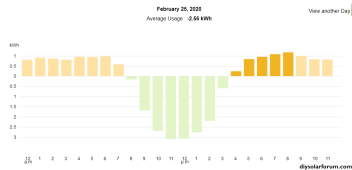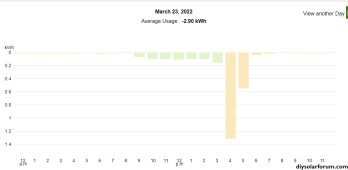Officially... No, my local AHJ and Electric utility have not inspected/approved my Schneider XW-Pro install. I did all of th wiring to code, and actually a bit above with the wire being 1 or 2 gauge steps heavier than required. The only reason I have not had it inspected is that by battery bank is not UL listed. I am using repurposed Chevy Bolt cells. They are in a pair of steep cabinets with proper BMS units and Class T fusing. It is just a tick more than half of what is in an actual Chevy Bolt that I could have parked in the garage, so what's the problem? And I am also running them in a narrower range and at far less current than in the car.
There is no doubt the electric utility can tell I am using energy time shifting storage.
About 3 years before I installed the Enphase system, they had already changed out my meter for a digital bidirectional unit. My old mechanical meter was constantly being miss read because the pointers were warping from the crazy heat here. One month they would bill me over 1,000 kilowatt hours extra, then the next month I would have a negative bill. But on the tiered billing, that didn't erase the incorrect high usage demand charges. I complained several times and they had to issue refunds. So they finally replaced the meter and me reading were then fairly consistent, so it was obvious meter reading errors.
The new meter has a separate counter for energy imported and energy exported. The energy in read out will never go backwards. If power flows out, it counts up the second counter instead. And since it is "Time of Use" it tracks the total power that goes in, AND the total power that goes out, and that is reported back to the utility, So Cal Edison in my case. The bill only shows the full hour total difference. I do not know how often the meter transmits the data. It could be every 5 minutes, or 15 minutes, I don't know. But it really does not matter. If I pull 10 KWHs and then export 10 KWHs, both counters go up by 10, but they bill me zero for that total hour.
When the Enphase solar originally went in, I was typically exporting close to 10 KWHs every day between 10 am and 3 pm. But then I would import pretty much all of it back again overnight until the sun came back up. Peak export rate could hit 3,000 watts. Peak import rate could hit over 5,000 watts in the summer with A/C running and using a hair dryer or the microwave. My daily totals would sit right about 2 KWHs of consumption. And the bulk of it was in the high rate 4 pm to 9 pm Time of Use block.
So I decided to add the battery system. At first, I had to manually command it to charge when I left for work each morning. I set the charge current fairly low, and had the charge limit and low voltage set close enough, that it took 10 KWHs to go from the low to high cut and then back down again.
So my consumption would go up an extra 1,000 watts or so if I left before the sun was up. Then my export would be 1,000 watts less because it was charging. And the battery would go full by 2 pm, and the export would jump up a bit before the sun went down. Then I had it set to just grid sell 2,000 watts for the 5 hours from 4 pm to 9 pm. It didn't even know how much power I was using. When the A/C was off, it might be exporting over 1,000 watts. And with the A/C and cooking etc., we would still consume up to 1,000 watts from the grid. Total daily usage actually increase a little due to the efficiency losses of the charging and inverter steps of the XW-Pro. But since I time shifted 10 KWHs from the cheap time of day to the high rate time of day, that cut my bill in half again. I was saving over $2.00 a day with that dumb setup. Both the import and export counters in the utility meter were counting about 10 KWHs less per day. My energy use "Duck Curve" was flattened dramatically. There is NO doubt that they can see this. But they have never asked me about it. I am using less power, and exporting less power. How is this a bad thing for them? They offer a cheaper total rate if I had an approved battery system. So I am actually paying them a little more then if I had a "legal" Powerwall installed. So I don't think they want to complain.
But then, about a year later, I finally got my PLC and the power meters working properly. I no longer have to manually start the charging, AND it tracks the extra power and adjusts the charge and export currents every 5 seconds. When the sun is up, I let it export up to just 60 watts until the battery is full. And it exports enough, so that I am powering all the loads, even back in my main panel, and a tiny 20-30 watts goes out to the grid while I am on battery power all night. This is what the energy consumption looked like with just the Enphase solar.

My net export was 2.56 KWHs, but it is a huge Duck Curve.
With my system charging properly, it now looks like this.

This is 13 months later, after I got the PLC dialed in and working great. Since it is a month later into spring, the solar produced a bit more, so my net export is up a little to 2.90 KWHs. But instead of drawing 1,000 watts all evening and over night, and then exporting 3,000 watts, I only exported 1,300 watts for 1 hour, and less than 600 watts for an hour, and 60 watts the rest of the time the sun was shining as the battery charged. The export spike is after the battery is full. Too bad the graph scales to always fill the height. That big spike is well less than half the export power from before the battery was working.
So yes, they know I am doing something, but it's not hurting them at all.
Now for th last 9 months, I also have DC panels helping to charge the battery bank. The curves don't look much different except the battery becomes full 1 or 2 hours earlier, and even on low production days, I usually make it all the way to sun up now, where without the DC panels, I would go to the 1,000 watts of grid power usage in the morning if the battery fell short.
My NEM 2.0 agreement states I am allowed to export up to 16 amps at 240 volts, but not to exceed 900 KWHs of export in any 30 day billing period. There is no place in the contract where it states when I can import or export energy. But there is also a rule for battery storage systems that you are not allowed to sell energy from a battery that was charged from grid energy. That rule is to prevent people from storing up 100 KWHs of cheap rate power and stuffing it into the grid at the high rate and making money off of the utility using their power. My system never exports more than my solar panels make, so I am not violating that rule either.
If I sell the house, I would either have to install UL rated batteries, or just remove the battery system. I am totally aware of that. And, if my house catches fire from an electrical problem, even if it has nothing to do with my battery system, it is possible my home insurance might not cover it, if they discover the un-permitted battery equipment in the garage. This is my bigger worry. My plan is that the batteries I have will last about 7 to 10 years with how I am running them. At that point, I will likely switch to something like server rack batteries, and then have the system permitted and made fully "legal".
My additional DC charging equipment may also have to go. The panels are CE rated to meet UL specs, so I might be able to get them through an inspection, an they are on the garage, not over the living space. But I currently don't have Rapid Shut Down on the DC panels. And the DC charge controller is a cheapo BougeRV unit from Amazon. It is only rated for "Off Grid" systems. All it does is charge the battery. But... That battery is them feeding into the grid interactive XW-Pro inverter. That is another grey area. I can pull out one Anderson plug, and then the DC system is just charging a spare battery. The other half of the battery bank will stay as the storage battery for the XW-Pro. "Oh, I just plug that in if the grid is down and I am Off Grid." That way the whole DC system is a separate off grid system.





